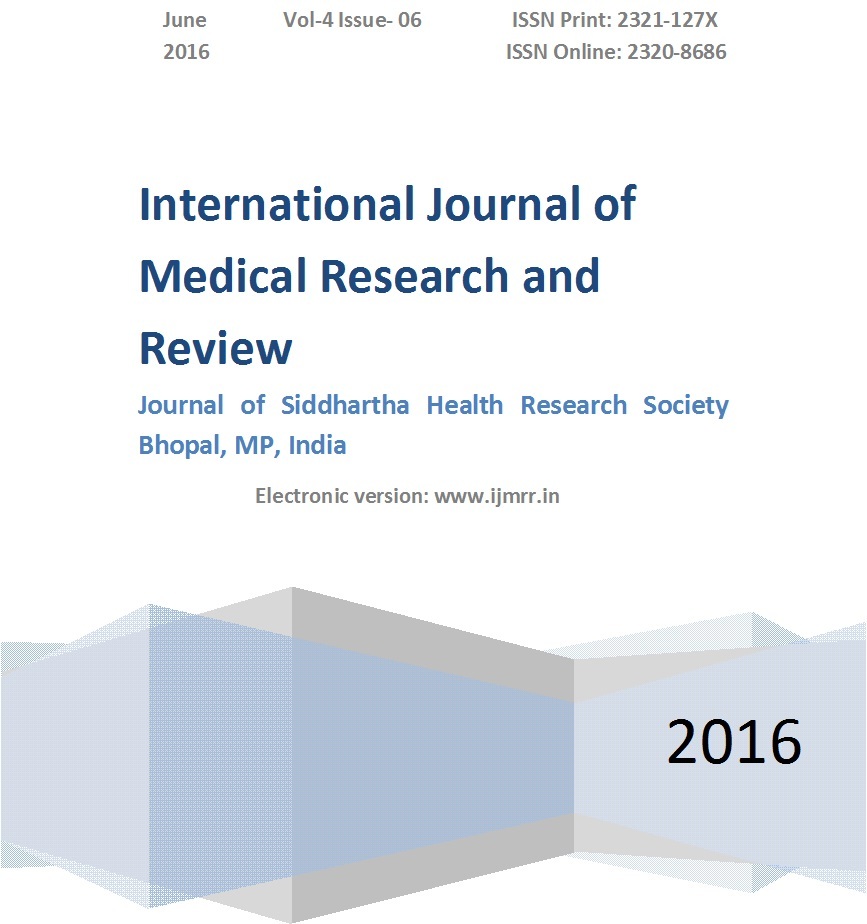Atherosclerosis regression of intima-media wall thickness of internal carotid artery with long term use of flavonoids & antioxidants
Abstract
Introduction: Free radicals of oxygen causes an abnormal intravascular lipid peroxidase activity and start process of atherosclerosis within blood vessels. Atherosclerosis reversal has been studied in humans and animals. Flavonoids are of plant origin and these are special antioxidant molecules. Arthrosclerosis regression was studied with long term use of Flavonoids and other antioxidants.
Material and Methods: This prospective controlled trial study was done on 80 ischemic heart disease patients with effort angina having ST segment depression or elevation of more than 1mm in their normal electrocardiogram. 46 subjects of Group A taken as STUDY group were given Flavonoids Antioxidant combination for a period of 9 months as an adjuvant therapy along with routine medical management. Results of baseline study were compared with follow up results of the same group and also with another 27 subjects of Group B taken as control.
Results: The results showed improved myocardial functions, improved lipid profile picture and highly significant reduction of Intima-media thickness of Common carotid artery examined with High resolution B-mode ultrasonography. Mean values of Intima-media thickness (mm) in case of experimental group were 0.92±0.11 at baseline and 0.84±0.10 at follow up. These results in control group at baseline were 0.93±0.12 and at follow up were 0.96±0.15. Data is statistically highly significant (p<0.001) in case of experimental group and not significant (p>0.05) in case of control group.
Conclusion: The results of study have clearly reflected that these compounds were able to reduce atherosclerotic plaque present in major and minor arteries.
Downloads
References
2. Sevil Gonenc et al. The effect of moderate swimming exercise on anti-oxidant enzyme and lipid peroxidation levels in children. Ind J. Phy Pharm. 2000; 44(3): 340-344
3. Scott J. Pathophysiology and biochemistry of cardiovascular disease. Cur. Opion. Genet. Develop. 2004;14:271–9.
4. Mehta JL. Mehta J. Antioxidant vitamins in your cardiac patient- are they helpful? Cardiology Review, 1999 Jan Feb; 7 (1) : 56-61.
5. Diane L. Tribble Antioxidant Consumption and Risk of Coronary Heart Disease: Emphasis on Vitamin C, Vitamin E, and β-Carotene. Circulation.1999; 99: 591-595doi: 10.1161/01.CIR.99.4.591
6. Farmer John A et al. Risk factors for Coronary Artery Disease, Heart Disease: A textbook of Cardiovascular Medicine (Ed. Braunwald) 4th Ed, 1992; 1125-1160.
7. James E. Klaunig, Lisa M. et al. Oxidative Stress and Oxidative Damage in Carcinogenesis Toxicologic Pathology, 2010;38: 96-109,
8. Noriko Noda, Hiro Wakasugi, Cancer and Oxidative Stress JMAJ 2001;44(12):535–539,
9. B González-Flecha, J. C. Cutrin. Time course and mechanism of oxidative stress and tissue damage in rat liver subjected to in vivo ischemia-reperfusion. J Clin Invest.; 1993;91(2): 456–464.
10. Ramos D, Martins E.G. Biomarkers of oxidative stress and tissue damage released by muscle and liver after a single bout of swimming exercise. Appl. Physiol. Nutr. Metab, 2013;38(5): 507-11.
11. Gonenc Sevil. The effect of moderate swimming exercise on anti-oxidant enzymes and lipid peroxidation levels in children Ind.J.Physiol. Pharmacol; 2000;44(3):340-344
12. Esterbauer H, Puhl H. Effect of antioxidants on oxidative modification of LDL. Ann Med.1991;;23(5):573-81.
13. Mehta JL, Iris Orbach. Role of new risk factors in coronary artery disease I.H.J.1997; 51:261-267
14. Stary HC, Chandler AB. A definition of initial, fatty streak, and intermediate lesions of atherosclerosis. A report from the Committee on Vascular Lesions of the Council on Arteriosclerosis, American Heart Association, Circulation. 1994;89(5):2462-78.
15. Lobo V. Patil A. Free radicals, antioxidants and functional foods: Impact on human health Pharmacogn. Rev. 2010 Jul-Dec; 4(8): 118–126.
16. Prithvi Raj T. et al. Reversal of Atherosclerosis: Fact or fiction? Cardiol.Today 2000 IV/2; :97-100
17. Blankenhorn DH, Hodis HN. Atherosclerosis--reversal with therapy. West J Med.; 1993;159(2): 172–179.
18. Rahman Khalid, Studies on free radicals, antioxidants, and co-factors, Clin. Interv. Aging. 2007 Jun; 2(2): 219–236.
19. Hodis HN. Reversibility of atherosclerosis evolving perspectives from two arterial imaging trials: The CLAS and MARS studies, J. Cardiovasc. Pharmacol1995; 25(suppl. 4): 525-531
20. Hoyert Donna L. 75 Years of Mortality in the United States, 1935–2010 NCHS Data Brief No. 88 March 2012.
21. Tully Phillip J and Baker Robert A. Depression, anxiety, and cardiac morbidity outcomes after coronary artery bypass surgery: a contemporary review J Geriatr Cardiol.2012; 9(2): 197–208.
22. Miller Allan L. Botanical influences and cardiovascular disease, Alter. Med. Review 1996 (3); 6: 422-431.
23. Rodolfo P. Antonio M. Gotto Jr. Atherosclerosis: Evolving Vascular Biology and Clinical Implications Inflammation in Atherosclerosis and Implications for Therapy, Circulation.2004 109 [suppl III]; III-20–III-26
24. Jain V. et al. Effect of T. arjuna in patients of angina pectoris, Ind. Med. Gazette 1992 (new); 36:56-59
25. Shaila HP et al. Hypolipidaemic activity of three indigenous drugs in experimentally induced atherosclerosis, International J. Cardiol 1998.; 67: 119-124
26. Ram Alpana et al. Hypochloestremic effects of T. arjuna tree bark, J. Ethnopharmacol.1997; 55: 165-169.
27. Moline J. et al. Dietary flavonoids and hypertension: Is there a link? Med. Hypothesis2000; 55(4): 306-309
28. E. N. Frankel et al. Inhibition of oxidation of human low density lipoproteins by phenolic substances in red wine The Lancet Vol. 341:: 454-457., Ann. Int. Med. 1996; 124(4): 548-56
29. Padmaja UK et al. Safety and efficacy of Hartone in stress angina pectoris- an open comparative trial JAPPI 1999; 47(7): 685-689
30. Harborne JB William CA. Advances in Flavonoids research since 1992, Phytochem. 2000;55(6), 481-504.
31. Ram Alpana et al. Hypocholesterolaemic effects of T. arjuna tree bark, Journal Ethnopharm, 1997; 55:165-169.



 OAI - Open Archives Initiative
OAI - Open Archives Initiative


